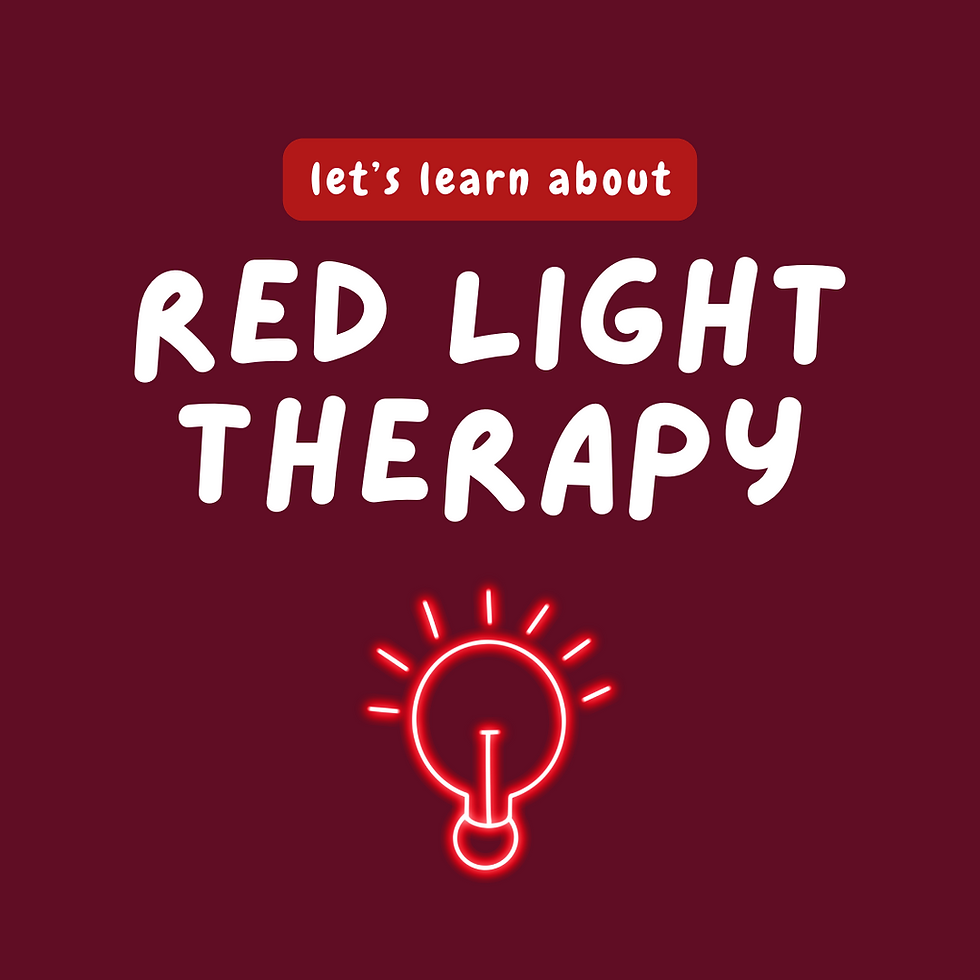Let's Learn About Red Light Therapy
- ANH Team

- Jan 13, 2024
- 4 min read
Updated: Jan 17, 2024

We are thrilled to introduce our newest addition at ANH Wellness: Red Light Therapy!
Red light therapy is a natural treatment that uses light wavelengths which our bodies are familiar with. This service can be added to your chiropractic adjustment, sauna session, or salt room during your next visit. Recent studies suggest that it can be an effective therapy alternative with many possible benefits, so let's learn more!
What is Red Light Therapy?
Red light therapy is a natural healing method that uses light wavelengths that our bodies are familiar with. It is a type of low-level light therapy (LLLT) or photobiomodulation (PBM) that employs light at specific wavelengths (600-100 nm) to control biological activity. This light stimulates healing cells in the body. By stimulating healing cells, we can hopefully relieve pain and reduce inflammation in the body. Red light therapy is thought to reduce oxidative stress in the body and promote healing by activating the energy centers of our cells. It may also stimulate collagen production, which is why it can be helpful in many different skin conditions. It can be applied throughout the body to help with certain medical conditions.
Red light treatment has been shown to benefit superficial structures such as the skin by treating wrinkles, psoriasis, acne, scars, and other skin disorders, as well as facilitating wound healing. It has also been used for deeper healing, including scar tissue, muscular adhesion, and tissue repair. It can be used to treat a variety of musculoskeletal disorders across the body, including tendonitis, arthritis, and carpal tunnel. It may also help with swelling or edema. Red light therapy is also thought to aid patients with preeclampsia, though further research is needed.
How did interest with Red Light Therapy evolve?
In the 1990s, scientists used light-emitting diode (LED) technology to grow potatoes in space. The powerful red LEDs promoted photosynthesis. It is also said to have accelerated the healing of wounds on the scientists' hands. Red light was then investigated for potential medical use during space travel. Researchers thought it would aid in the treatment of muscular atrophy, delayed wound healing, and bone density concerns caused by weightlessness in space. Although RLT is gaining popularity as a dermatological treatment for specific disorders, further clinical research is required to fully support its claimed advantages.
So how does Red Light Therapy actually work?
Red light therapy is a non-invasive procedure that applies low-level wavelengths of red or near-infrared (NIR) light to the body or significant areas of the body. Photons, or single units of light, are absorbed during therapy by photosensitive molecules in your skin cells. This can result in less inflammation, more tissue repair, and faster skin healing. RLT works by repeatedly exposing your skin to low quantities of red infrared light over a set length of time. This type of red light exposure may produce a positive biochemical effect in your cells that strengthens the mitochondria, which is where the cell’s energy is created. By increasing the energy of the mitochondria, cells may function more efficiently, as well as rejuvenate and repair themselves.
A red light treatment device delivers low-intensity red and near-infrared light deep into the body's cells, promoting healing. Red light treatment is non-invasive, painless, and does not involve heat. Those seeking the maximum benefit from red light treatment should first consider trying it in a clinical setting. Red light therapy is designed as a supportive treatment. It's unlikely to be the only treatment you use to treat a health or skin condition, but it could be another great tool to add to your arsenal of remedies!

Are there health conditions where Red Light Therapy may not be beneficial?
Red light treatment is contraindicated when used on malignant cells. The data is mixed on whether or not red light treatment is safe to use with cancer, so avoid it if you have been diagnosed with cancer or are undergoing radiation or chemotherapy. It is recommended that you use eye protection while using red light treatment. Red light therapy, unlike ultraviolet (UV) light, does not cause damage. It is widely accepted as safe for use in a variety of circumstances. However, it is not recommended to use red light treatment for more than 30 minutes to reduce the danger of burns or blisters. Be sure to check with your provider before using red light therapy if you are pregnant.
To Summarize
Red light therapy is an effective treatment that has many potential benefits. Depending on the area being treated, red light therapy treatments have different frequencies and wavelengths. Your healthcare provider or dermatologist will be able to advise on the treatment frequency and appropriate wavelength of light to help treat a specific condition.
With that stated, it's good to know that the field of phototherapy continues to advance and more research is required to find the optimal applications depending on certain wavelengths, doses, and devices for various medical issues. This promising new treatment on the horizon may help with various medical conditions. Be sure to ask about it at your next chiropractic visit!
By: Dr. Megan Stavalone
Perinatal Certified Chiropractor at ANH Wellness
Disclaimer: This blog is not a substitute for medical advice. Please speak with your physician before starting red light therapy. "The information including but not limited to text, graphics, images, and other material contained on this website is for informational purposes only. No material on this site is intended to be a substitute for professional medical advice, diagnosis, or treatment."
Sources: Griffin J, Krolikowski JG, Kounga K, Struve J, Keszler A, Lindemer B, Bordas M, Broeckel G, Lohr NL, Weihrauch D. Red Light Mitigates the Deteriorating Placental Extracellular Matrix in Late Onset of Preeclampsia and Improves the Trophoblast Behavior. J Pregnancy. 2022 Apr 20;2022:3922368. doi: 10.1155/2022/3922368. PMID: 35494491; PMCID: PMC9045993. Hamblin MR. Mechanisms and applications of the anti-inflammatory effects of photobiomodulation. AIMS Biophys. 2017;4(3):337-361. doi: 10.3934/biophy.2017.3.337. Epub 2017 May 19. PMID: 28748217; PMCID: PMC5523874. Tsai SR, Hamblin MR. Biological effects and medical applications of infrared radiation. J Photochem Photobiol B. 2017 May;170:197-207. doi: 10.1016/j.jphotobiol.2017.04.014. Epub 2017 Apr 13. PMID: 28441605; PMCID: PMC5505738.



Comments